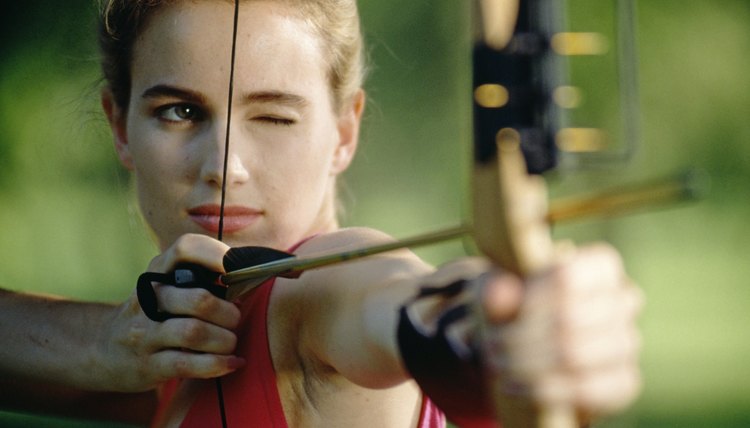Archery and Shoulder Injuries

Archery requires strong shoulders as they must bear the resistance exerted by the bowstring when it's pulled back. Over time, this can result in shoulder injuries if you don't use proper form and archery techniques. Though many archery-related shoulder injuries are minor and heal with rest, some injuries may be severe enough to require medical treatment or surgery to correct.
Stresses of Archery
Each time you pull back the string on a bow, strain is placed on the muscles of your shoulders, arms and back. The shoulder of the arm holding the bow tightens so your arm can push against the bow while the shoulder of your other arm pulls so you can pull back the string. This tension increases gradually as the bowstring is pulled back with a smooth and steady motion. When the bowstring is released, the arms are braced against the sudden release of tension as the string draws taut.
Shoulder Injuries
Three main types of injuries to the shoulders occur in archery. Injuries to the rotator cuff occur when the tendons of the four muscles that connect around the shoulder joint become torn or otherwise injured; this damage can present itself as an actual rotator cuff tear or as irritation and swelling known as a rotator cuff impingement. Muscle strains can occur to the muscles of the rotator cuff and to muscles of the arm or upper back when they are overworked or overextended, resulting in tears and damage to the muscle fibers themselves. Another injury known as archer's shoulder occurs when the shoulder itself becomes dislocated as a repetitive stress injury, resulting in pain and shoulder instability.
Other Pains
Not all shoulder pains associated with archery involve injuries to the rotator cuff or other shoulder muscles. Bursitis can occur when the repeated actions of drawing the bowstring cause the fluid-filled bursae that provide padding for the tendons of the shoulder become inflamed. Tendinitis and tendinosis can also occur, with the former being caused by traumatic injury to the tendons of the shoulder while the latter is caused by microscopic tears in the tendons that develop over time. Archery can also cause damage to the brachial plexus nerve cluster that runs through the shoulder and into the arm, especially if the connective tissue of the shoulder is already irritated and swollen because of other conditions.
Causes
The two primary causes of shoulder injuries and irritation are improper archery form and using a bow with too high of a pull weight. Using improper form such as jerky draw motions and poor arm positioning places excessive strain on the shoulder joint and the muscles that connect to it, increasing the likelihood of injury and irritation. Using a bow with too high of a pull weight also increases the strain on the shoulder joints and their connective tissues by exceeding the limits of your arm and shoulder strength while drawing the bow.
Treatment
Minor shoulder pains and inflammation can be treated using over-the-counter anti-inflammatory medications, rest and ice. More severe injuries may require medical care or even surgery to correct. A doctor should be consulted for diagnosis when the pain first presents itself even if the pain doesn't seem severe; early diagnosis and treatment prevents shoulder injuries from getting worse due to continued stress being placed on the already-injured shoulder. Give yourself sufficient time to recover from shoulder injuries before you begin shooting again to prevent a recurrence of the same injuries that haven't fully healed.
Injury Prevention
There are several precautions that you can take to reduce the likelihood of shoulder pains and injuries during archery. Performing shoulder-specific stretching exercises such as the arm-up rotator stretch and the rotating stomach stretch prepare the muscles and tendons for use, decreasing the chance of injuries while drawing and shooting. Strength-training exercises that focus on the muscles of the arms, shoulders and back such as bicep curls and rowing exercises also help to prevent archery-related shoulder injuries by strengthening the muscles used in archery so they are less likely to become damaged by repeated motions. Proper hydration, getting sufficient rest before shooting and eating a snack or light meal that is high in protein and carbohydrates an hour before shooting can also help prevent injuries as it ensures that your muscles are rested and have the fuel and hydration necessary to perform repeated motions safely.
References
- World Archery Federation: Coaches Manual, Level 1 - Chapter 3 - Safety
- PubMed: Shoulder Injuries in Archery
- The Stretching Institute: Archery Stretches and Flexibility Exercises
- The Bowsite: The Bowsite's ER -- Shoulder Injuries
- Medscape Family Medicine: Can Archery Cause Brachial Plexus Injury?
- Bow Hunting: Archery Muscle Power
Writer Bio
Born in West Virginia, Jack Gerard now lives in Kentucky. A writer and editor with more than 10 years of experience, he has written both articles and poetry for publication in magazines and online. A former nationally ranked sport fencer, Gerard also spent several years as a fencing coach and trainer.
